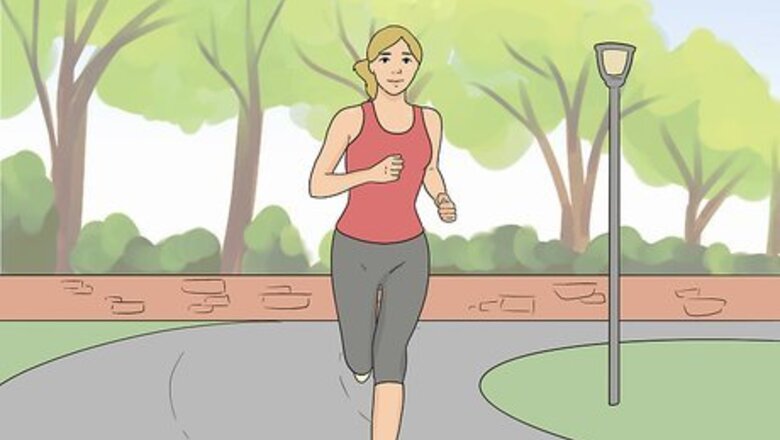
views
What is “runner’s face”?
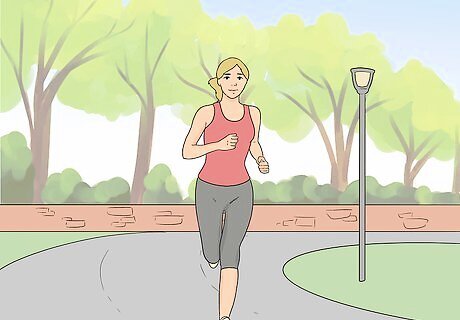
“Runner’s face” is a term for premature facial aging caused by running. The idea is that long-distance running can cause saggier skin, more gaunt cheeks, and an overall older appearance due to the high-impact pounding. “Runner’s face” is not an official medical term, and it hasn’t been backed up by scientific studies. However, the term has been gaining a lot of traction on social media lately, with many users chiming in about whether or not there’s any truth to the theory. A viral TikTok video by @geraldimbermd, a New York-based plastic surgeon, added fuel to the fire. In the video, Dr. Imber asks, “Have you ever seen a long-distance, longtime runner that didn’t have a gaunt, old face? That’s what happens.” To be fair, Dr. Imber also says it’s “perfectly fine to run a little bit every day,” or to “run a couple of miles a few times a week,” but he suggests that the risk for premature aging comes into play for those who frequently run long distances. Meet the wikiHow Experts Kaveri Karhade, MD, is a board-certified laser, medical, and cosmetic dermatologist with advanced training in injectables, lasers, surgery, and other cosmetic treatments. Adebola Dele-Michael, MD, FAAD, is a board-certified dermatologist with over 12 years of experience. She specializes in general and cosmetic dermatology, specifically using lasers and energy devices in treating skin of color. Daniel Barrett, MD, is a board-certified plastic surgeon and the owner of Barrett Plastic Surgery in Beverly Hills. He specializes in aesthetic and reconstructive surgery of the face, nose, and body. R. Sonia Batra, MD, MSc, MPH, is a board-certified dermatologist and the founder of Batra Dermatology in Los Angeles, and she specializes in lasers and medical devices. Paul Friedman, MD, is a board-certified dermatologist with over 25 years of experience, specializing in Mohs micrographic surgery, dermatologic laser surgery, and cosmetic dermatology.
Does running actually age your face?
No, running does not age your face prematurely. The answer to this question is a bit complicated, but technically, no—the act of running itself does not age your face prematurely. There isn’t scientific evidence to back up the claim that the high-impact movement causes skin to lose elasticity and sag, making you look older. That aspect of the popular TikTok theory is an urban myth. In fact, running could actually fight against skin aging, since exercise can improve circulation and boost collagen production. However, there are a few lifestyle factors and body types associated with long-distance running that can lead to premature aging, such as prolonged sun exposure or lower body weight. In other words, an aged appearance could be correlated to long-distance running, but it isn’t necessarily caused by it—there are more factors at play. We’ll go over the possible causes of premature aging in runners in more detail below.
What causes “runner’s face”?
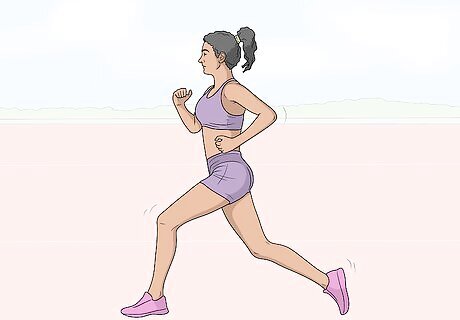
Prolonged sun exposure Too much exposure to the sun’s UV rays is known to cause premature skin aging, and long-distance runners tend to spend a lot of time out in the sun. Over time, running long distances outside without adequate SPF protection can cause skin to lose elasticity and appear thicker, leathery, wrinkly, or thin, which are all traits associated with “runner’s face.” Keep in mind, though, that these effects could show up as a result of doing any outdoor activity for a long period of time. Surfers, cyclers, hikers, skateboarders, and more could be at risk if they don’t use adequate sun protection, which is why it wouldn’t be accurate to say that running itself is the cause.
Lower body weight Long-distance running burns quite a few calories, which means it can help people lose weight or maintain a lower body weight in general. Having less fat in the face can contribute to a more gaunt or hollow appearance, and significant weight loss can lead to sagging or loose skin in the face. These traits are often associated with a more aged appearance, hence the “runner’s face” fears. Similarly to the sun exposure situation, a lower body weight or weight loss could be associated with any intense exercise, so the act of running itself is not the primary culprit.
Natural loss of facial volume Finally, these facial changes might just be the natural aging processes that runners would experience regardless of their exercise habits. “As we get older, our collagen tends to break down, and we stop producing elastin, which is what makes young skin look bouncy,” explains board-certified dermatologist Kaveri Karhade, MD. At the end of the day, it’s completely normal for someone’s face to change over time! In other words, if you’ve started to notice skin changes after many years of running, it’s entirely possible that you’re just experiencing the natural process of aging, rather than any kind of negative effect from running. And there’s nothing wrong with that! In fact, aging is pretty darn beautiful. Regardless, if you’re a runner who’s concerned about “runner’s face,” there are a few steps you can take to prevent premature facial aging or treat it if you feel it’s already started. We’ll get into both of these topics more in the following sections.
How to Prevent “Runner’s Face”
Wear sunscreen every time you run. According to Dr. Karhade, the natural effects of aging are “exacerbated by sun exposure,” so “wearing sunscreen as early as possible is one of the best ways to keep your skin young.” In general, it’s recommended that you wear a sunscreen with an SPF of 30 or higher on a daily basis, even when you aren’t running, to protect you from premature aging and skin cancer. When you are running outside, it’s all the more essential that you remember to apply your sunscreen beforehand to protect your skin! Here are some tips to keep in mind: Apply your SPF 30 or higher sunscreen about 15 minutes before going outside, since it takes your skin 15 minutes to fully absorb the sunscreen. Make sure to use enough of the product. You don’t want an uneven coating of SPF! Apply a generous amount to all the areas of your body that will be uncovered and exposed to the sun, not just your face. Reapply your sunscreen every two hours, or earlier if you’re sweating profusely. You may also want to consider wearing wide-brimmed hats or sunglasses for extra layers of protection from the sun.
Try to limit running in direct sunlight. The sun is strongest from around 10:00 a.m. to 4:00 p.m., so it’s best to avoid running outdoors during those hours. This also helps you avoid exercising during the hottest parts of the day during the summer months, which can be dangerous, too.
Maintain a healthy body weight, and lose weight slowly if you’re on a weight loss journey. A few of the main concerns surrounding “runner’s face” are loose, saggy-looking skin or a gaunt look, which can occur when someone loses a significant amount of weight suddenly (see the “Ozempic face” fears). According to board-certified dermatologist Adebola Dele-Michael, MD, FAAD, “Fat has a way of cushioning the skin and making the skin taut,” so these facial changes “can happen when someone loses a lot of fat.” If you’re running as part of a weight loss journey, try to lose weight gradually versus rapidly. “If you lose weight at a slower rate, you’re going to allow your skin to keep up with that weight loss,” explains certified personal trainer Pete Cerqua. A rate of 1-2 pounds per week is generally considered safe. Or, if you’re a runner who tends to have a lower body weight naturally, make sure you’re eating enough to fuel your intense workouts and avoid becoming underweight. In general, a BMI of 18.5 to 24.9 is considered normal, while a BMI of under 18.5 is considered underweight.
Follow an anti-aging skincare routine daily. When it comes to preventing wrinkles, “a daily skincare regimen using retinol and vitamin C is a must,” says board-certified plastic surgeon, Daniel Barrett, MD. Dr. Karhade seconds this suggestion: “Using a product like retinol at nighttime can help increase collagen growth,” she says. It’s a good idea to consult a dermatologist for help crafting a skincare routine, since everyone’s needs are different, but here’s a basic example: In the morning, wash your face with a gentle facial cleanser, then apply a facial moisturizer, vitamin C serum, and SPF 30 (or higher) sunscreen. In the evening, wash your face with a gentle facial cleanser, then apply a facial moisturizer and a retinol. This could either be a prescription-strength retinol (such as tretinoin) or an over-the-counter retinol product.
Stay hydrated and eat a healthy diet. Runners sweat out a lot of fluid, especially when running outdoors in the heat, so it’s essential that you drink enough water to keep your body functioning properly. Beyond this, a diet high in antioxidants and/or essential fatty acids can help fight skin aging and keep your skin looking youthful and glowing. These types of foods include salmon, dark green leafy vegetables, avocado, and nuts and seeds.
Avoid or quit smoking. If you want to prevent premature aging, steering clear of smoking is one of the best things you can do. “The smoke itself is tremendously aging, and the act of smoking breaks down collagen just because of the chemicals in cigarettes,” explains board-certified dermatologist R. Sonia Batra, MD, MSc, MPH.
Can you treat “runner’s face”?
Yes, there are treatments you can do to reduce the appearance of aging. If you’re concerned about the traits of “runner’s face,” such as aged skin or a gaunt look, consider scheduling an appointment with a dermatologist. They’ll be able to recommend any treatments or procedures that might work for your unique situation. “There are various types of injectables, such as fillers or various types of botulinum toxin products, that can help relax muscles temporarily to soften the appearance of lines that result from sun damage, and then fillers help to restore the volume loss,” explains board-certified dermatologist Paul Friedman, MD. Or, if your concern is loose skin due to weight loss, Dr. Dele-Michael explains that “skin-tightening treatments done using lasers and energy devices, such as radio frequency devices or ultrasound devices,” can be helpful.
The Bottom Line
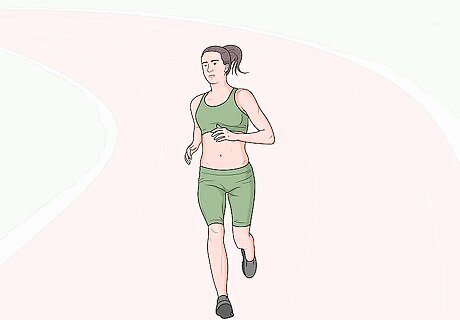
The act of running itself doesn’t prematurely age your face. Contrary to popular belief on TikTok, the high-impact bouncing motion of running doesn’t cause your skin to loosen or sag. However, other lifestyle factors associated with runners, like prolonged sun exposure and low body weight, can have an effect on facial appearance. To prevent premature skin aging, wear sunscreen and protect yourself from the sun when you’re running outside. To avoid a gaunt or hollow facial appearance, avoid becoming underweight and fuel your workouts with enough food.















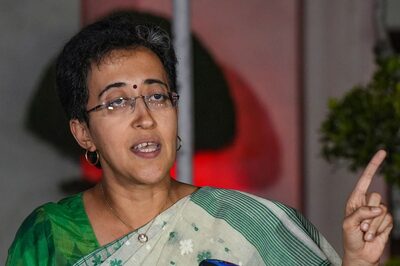


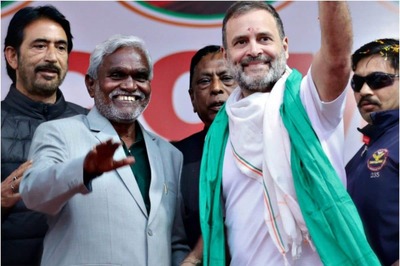

Comments
0 comment